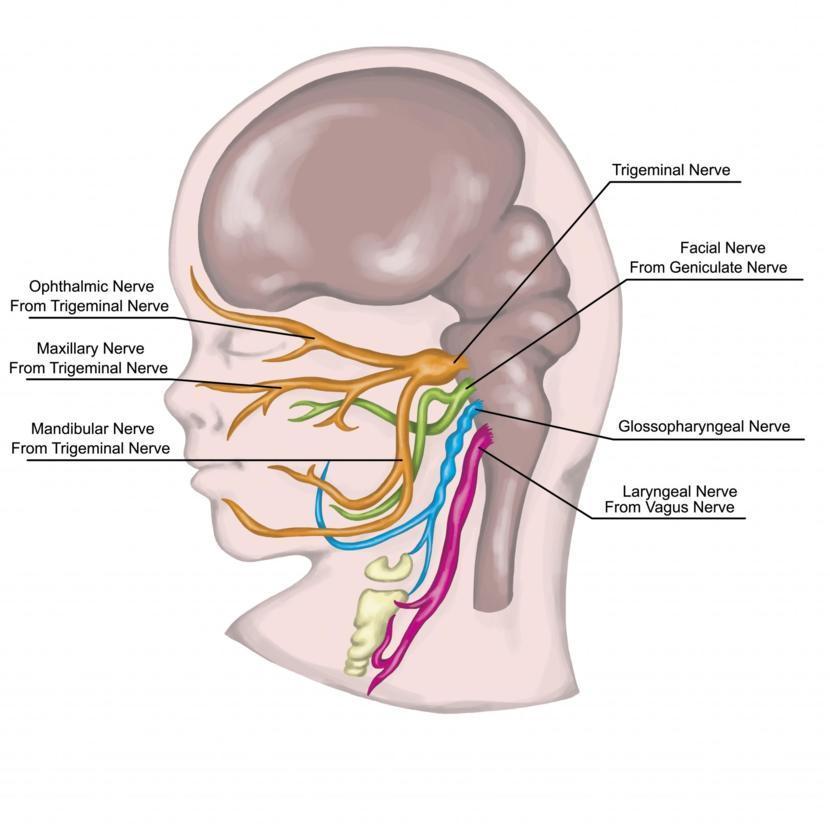The Craniofacial Pains: Clinical Features and Treatment

Dr. Paul Kiritsis, PsyD, MScMed, is a licensed medical psychologist practicing in Redwood City, California. He specializes in the diagnosis and multimodal treatment of neuropsychiatric and functional neurological disorders, as well as coordinating care for patients suffering from these ailments. He offers heterogeneous... more
As mentioned in an earlier post, craniofacial pains–the third type of established headache syndrome–are a unique category because they can be primary or secondary. It includes a whole continuum of weird and wonderful conditions, including painful cranial neuropathies and neuralgias. Of the latter, trigeminal neuralgia is a well-recognized paroxysmal entity, commonly described by patients as a unilateral “electric shock-like pain” emanating from trigger zones like the maxilla and mandible, both of which receive sensory innervation from the secondary [V2] and tertiary [V3] divisions of the trigeminal nerve, respectively. Chronicity is distinct, with paroxysmal pain appearing instantaneously and lasting no more than about a second. Some permutations may involve a repetitive 5-30 second train of unremitting pain pangs. Triggers include mechanical actions like chewing, biting, brushing one’s teeth, touching, and even something as innocuous as having the wind caress one’s cheek. In the aftermath of an acute attack, a residual dull albeit lingering ache may persist. Dehydration, weight loss, and even the debilitating woes of depression can be undergirded by unremitting pain of this type.
While idiopathic trigeminal neuralgia is considered a benign condition with the stabbing, lancinating pains merely epiphenomena of trigeminal nerve root impingement by the superior cerebellar artery [most common blood vessel associated with the condition], the co-occurrence of this symptom-picture with physical signs like sensory loss and paraesthesias or weakness of muscles responsible for mastication is a harbinger of something far more sinister like a life-threatening structural lesion. Roughly 15% of trigeminal neuralgia cases are caused by space-occupying lesions. The preponderance of physical symptoms should galvanize urgent and aggressive diagnostic investigation, with a standard protocol involving an order of a contrast-enhancing MRI [or comparable neuroimaging] with fine cuts of the skull base to screen for a potentially life-threatening acute vascular accident like a pontine lacunar stroke, a subacute demyelinating plaque caused by multiple sclerosis (MS), or a slow-growing tumor like a meningioma or schwannoma of the posterior fossa [cranial cavity housing brainstem and cerebellum]. Any younger individual with the abovementioned symptom picture, especially one of the mutable qualities that evolve, should seek medical attention without delay. The same sentiment extends to those assailed individuals with a history of dental disease, given that microabscesses can either masquerade as or precipitate trigeminal neuralgia.
Trigeminal neuralgia waxes and wanes over the years, with protracted periods of alleviation and worsening. Most sufferers opt for medical management, typically a 100-600mg/day prescription of the antiepileptic carbamazepine (Tegretol) titrated until absolute pain control is achieved. Therapeutic response to carbamazepine tends to be a feature of the condition. There are surgical options available for the minority who are medication refractory [approximately 25% of TN patients]. The most efficacious and enduring is microvascular decompression, an invasive technique involving a posterior fossa craniotomy whereby the “vascular loop” compressing and irritating the trigeminal nerve is mobilized and separated using Teflon. Typically reserved for the physically robust the procedure preserves facial sensation, addresses the underlying mechanism, and is associated with prolonged durations of pain relief. The median time to recurrence of paroxysmal pain is 10-15 years, rendering it superior to less invasive alternatives like percutaneous rhizotomy and gamma knife stereotactic radiosurgery. Percutaneous rhizotomy is an ablative procedure targeting the gasserian ganglion [convergence point for the three divisions of the trigeminal nerve which provide cutaneous innervation for the face before it enters the brainstem] and does, in some circumstances, result in unremitting focal numbness. Stereotactic radiosurgery, the least invasive option, delivers a single dose of radiation to the cisternal segment of the trigeminal nerve with millimetric precision, however, it takes about a month to take effect and is associated with postoperative dysesthesias.
There are two other neuralgias worth noting–glossopharyngeal neuralgia and occipital neuralgia, both named after the neuroanatomical and neurophysiological regions they affect. Qualitative aspects of the pain associated with glossopharyngeal neuralgia mimic those of trigeminal neuralgia, with disparities confined exclusively to the respective spatial distributions each neuralgia affects. Glossopharyngeal pain commences in the throat, larynx, and nasopharynx, with lateral emanations projecting deep into the aural canals. Analogous to trigeminal neuralgia, attacks are unilateral and triggered by mechanical acts like coughing, sneezing, swallowing, speaking, and laughing, or radical alterations in alimentary temperature (i.e., eating something frigid or hot). Often the pain may awaken somebody from their slumber. Incidences may be idiopathic, or sequelae of structural lesions caused by tumors or malignancies and in some cases peritonsillar infections. Treatment of this condition is pharmacological or surgical and consistent with those used for trigeminal neuralgia.
A unilateral headache of sudden onset in concert with episodic paroxysmal jabbing pain radiating over the occipital distribution of the head is a hallmark sign of occipital neuralgia. There may be dysesthesia and dearth of sensation in the occipital nerve distribution (C2, C3), and palpation of the occipital condyle–the unique bony structure linking the cranium and vertebral column–sometimes replicates the pain and reveals local tenderness. Conventional theory ascribes the symptomology to occipital nerve entrapment by neck and scalp musculature, however, surgical interventions find that the etiology is most often injury to the C2-C3 nerve roots inflicted via whiplash, trauma, or inflammation. In many cases where such symptoms abound, however, structural MRI reveals that compression of the upper cervical roots is absent. When this diagnosis is suspected, an occipital nerve block with lidocaine injection may ameliorate the pain; such a clinical scenario corroborates the diagnosis. Symptomatic relief with antiepileptics like carbamazepine (Tegretol) and gabapentin (Neurontin) may be sought if an occipital nerve block is ineffective.
In conclusion, the most important thing to remember when it comes to established headache syndromes is chronicity (i.e., is it chronic, subacute, or acute) and qualitative features (i.e., mild or moderate throbbing pain, lancinating or stabbing severe pain, and so forth), especially in an individual with a prior headache history. When in doubt about whether any headache represents a medical and neurological emergency, recourse to the acronym SNOOP: (1) systemic symptoms like weight loss or fever, or secondary risk factors like immunosuppression due to HIV and malignancy, (2) neurological focal signs like loss of visual acuity or eye pain, and fluctuating conscious awareness, (3) onset of a thunderclap headache, usually described by patients as the “worst headache of my life,” (4) older patient [+50yrs] with a new and progressively worsening headache, and (5) previous headache history: a headache with features and of a severity disproportionate to the headache types usually experienced by a particular individual.








